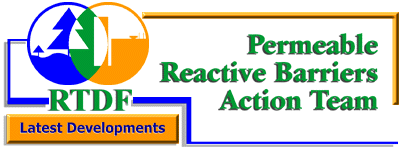 |
|
||||||
|
|
|
||||||
|
|
|||||||
 |
|
||||||
|
|
|
||||||
|
|
|||||||
|
Installation Date: Contaminants: Reactive Media: Cost: Construction: Point of Contact: |
|
|
A full-scale permeable reactive barrier (PRB) system was installed in 1999 to remediate contaminated ground water at Haardkrom A/S, a former electroplating facility in Kolding, Denmark. The metal plating process used chromium, nickel, zinc, and the degreasing agent, trichloroethylene (TCE). Major ground-water contaminants of concern are TCE and hexavalent chromate. Concentrations of TCE in ground water range from 40-1,400 µg/L. Cr+6 concentrations in hot spots in the ground water are 8-110 mg/L. The upper 6.5-10 ft of the ground at the site consists of a low permeability, heterogenous mixture of sandy and clayey loam interspersed with local lenses of sandy layers. The aquifer in these upper layers is less than 6.6 ft below ground and is not continuous throughout the site. Although the direction of ground-water flow is mainly north by northeast, the direction seems to change with the seasons. The availability of construction techniques in Denmark and cost considerations weighed heavily in the selection of the PRB design, which consists of a continuous trench. The PRB is 164 ft long, 3.3-9.8 ft deep, and 3.3 ft thick. An excavation box was used to install the trench because of the low permeability of the soil. The PRB designers accounted for the limited capacity of chromate removal in PRBs and set the dimensions of the trench to accommodate all of the Cr+6 in the plume. Laboratory experiments showed chromate reduction capacities to be in the order of 1-3 mg Cr+6/1 g Fe0. The results of the first year of operation suggest that the design is not effectively controlling the uneven distribution of contaminants along the PRB, especially Cr+6. Heterogenous loading of the PRB and dispersion of the contaminant plume have contributed to the exhaustion of iron-chromate removal capacity in the wall. Spatial monitoring that involves a detailed flow investigation is ongoing. If the design problems can be resolved quickly, sampling will occur every 6 months in 2001 and probably once a year thereafter. The full-scale demonstration phase of the PRB will end by the close of 2001. |
![]()
Sponsored by the Technology Innovation Program
Date Last Modified: May 31, 2001